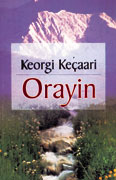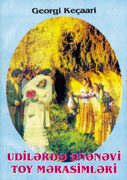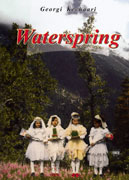|

Autumn 2003 (11.3)
Page
42
Udi Language
Comparing
Ancient Albanian with Contemporary Udi
by
Zaza Alexidze
Related Articles
1 Caucasian
Albanian Alphabet: Ancient Script Discovered in the Ashes
- Zaza Alexidze and Betty Blair
2 Quick Facts: Caucasian
Albanian Script - Alexidze and Blair
3 Albanian Script: How
Its Secrets Were Revealed? - Alexidze and Blair
4 Zaza Alexidze. Decipherer:
Glimpses of Childhood - Blair
5 Caucasian Albanian Script:
Significance of Dechipherment - Alexidze
6 Udins Today: Ancestors of
the Caucasian Albanians - Zurab Konanchev
One of the most significant
aspects about the discovery and decipherment of the Caucasian
Albanian written script is that there is a living community today
that speaks this language - the Udins who live primarily in Azerbaijan.
The Udi language belongs to the Lezgian Group of the Dagestani
Branch of the Caucasian Language Family.
Historians date the Caucasian Albanian written script to the
5th century - more than 1,500 years ago. They believe that since
the 10th century, or perhaps even earlier, the written form of
this language ceased to exist [See Quick Facts: "How the
Caucasian Albanian Script Probably Disappeared" in this
issue].
That's why the proximity that exists between the Albanian script
and the Udi language as it is spoken today is quite remarkable.
It was thought that over such a long period of time, greater
differences would have evolved in the language since it did not
have a script to fix or anchor its grammar and vocabulary.
Today, there are an estimated 8,000 ethnic Udins, who live primarily
in the Caucasus. They are concentrated mostly in two villages
in northern Azerbaijan near Gabala (formerly called Gutgashen).
The largest settlement is Nij and a smaller group live in the
Oghuz region (previously called Vartashen). A third community
immigrated to Georgia in 1920-1922, allegedly for economic reasons.
They call their village Zinobiani, after their leader Zinobi
Silikasvili. Previously, it was called Oktomberi by the Bolsheviks
after "The Great October Revolution" of 1917. There
are also some Udins who live in Georgia's capital, Tbilisi. Other
small groups are scattered throughout Russia, Armenia, Turkmenistan
and Kazakhstan.
Above: (From left to right) 1. Orayin by Georgi
Kechaari, 2000. First literary book. In Udi (Latin modified script
with 52 letters). 2. Traditional Udi Wedding Traditions by Kechaari,
2003. In Azeri. 98 pages. 3. Dance Around the Fire (Examples
of Udi Folklore) compiled by Kechaari, 2002. In Azeri. 102 pages.
4. Waterspring by Georgi Kechaari, 2002. In English. 24 pages.
The Norwegian Humanitarian Enterprise (NHE) sponsored these four
booklets related to the Udi culture, plus four others these past
three years.
This close relationship between the written Caucasian Albanian
text and its descendent - the modern-day Udi language - confirms
the scholarship of Georgian Akaki Shanidze who concluded in 1937
that Udi was the language represented by the Caucasian Albanian
script. He based his research on a 15th-century Armenian grammar
discovered in Yerevan by Georgian Ilia Abuladze. This manuscript
illustrated what some of the known alphabets in the region looked
like, such as Greek, Hebrew, Georgian, Syrian, Coptic, Arabic
and also Albanian.
One of the ways that linguists determine the genetic proximity
of languages is by comparing certain classifications of words;
for example: terms related to kinship, body parts, the galaxy
and natural phenomena. Also they compare personal pronouns, numerals
and action verbs as well as verbs that express physiological
needs such as hunger. It turns out that terms for such words
in both Albanian and Udi are, indeed, very close. Here are a
few words (in English transliteration) to illustrate words that
are exactly the same in modern everyday usage in Udi as well
as the 5th century written Caucasian Albanian script which was
found among the manuscripts at St. Catherine's Monastery in Mt.
Sinai, Egypt.
Back to Index
AI 11.3 (Autumn 2003)
AI Home
| Search | Magazine
Choice
| Topics
| AI Store | Contact us
Other Web sites
created by Azerbaijan International
AZgallery.org | AZERI.org | HAJIBEYOV.com
|




